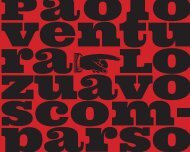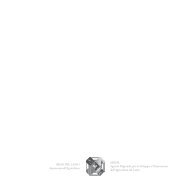Giuseppe Cavalli
Giuseppe Cavalli
Giuseppe Cavalli
- No tags were found...
You also want an ePaper? Increase the reach of your titles
YUMPU automatically turns print PDFs into web optimized ePapers that Google loves.
s i zed by Italo Zannier – on the wo rk of Vi n c e n zo Balocchi and, above all, Achille Bologna.<br />
In 1942, the volume 8 fo t o grafi italiani d’ogg i was published by the Istituto Italiano d’Arti Grafiche in Berga m o. The square<br />
fo rm at and black cover with white and red lettering we re simple, refined, and perfectly re flected the contents. In this book<br />
C avalli was described as a “Photographer and artist with gre at intuition, whose still lifes are the result of p a i n s t a k i n g<br />
re s e a rch; they spring from an inner fo rc e. Many photogr a p h e rs compose more or less interesting still lifes, <strong>Cavalli</strong> ‘cre at e s ’<br />
them.”<br />
L ater he met Federico Ve n d e r, the director of the Milan Photographic Club, whose contribution was vital in setting up<br />
La Bussola. “We believe in photogr a p hy as Art. This modern and sensitive means of ex p ression has ach i eved with the help<br />
o f the tech n o l o gy that ch e m i s t ry and mechanics has placed at our disposal, the fl ex i b i l i t y, richness and eff e c t i veness of a n<br />
i n d ependent and vital language. Hence it is now possible to be poets, the camera can transfo rm reality into fantasy: the prim<br />
a ry, indispensable condition of art.” The aim was to produce photogr a p hy that went beyond mere documentation, then<br />
seen as a ‘blind alley’; the subject had almost no artistic importance and the photographer shot, and could shoot, just wh at<br />
he felt. The La Bussola Manifesto was published in Fe rra n i a, founded in Ja nu a ry 1947, fo l l owing in the fo o t s t eps of the Ivre a<br />
m a gazine Notiziario fo t o gr a f i c o. At that time the editor was the eminent photographer Alfredo Orn a n o. The maga z i n e ’s<br />
scope was wide-ranging, surpassing the limited confines of the photographic clubs and their provincial mindset.<br />
In Fe b r u a ry 1943, Domus published the Annuario di fo t o gra f i a in wh i ch two images by <strong>Cavalli</strong> we re rep roduced: Wheat<br />
grass and Olive Trees and Blind Doll, rep resenting two seemingly diff e rent aspects of his re s e a rch: on the one hand, a sund<br />
re n ched, silent Mediterranean landscape that was fairly descriptive and stro n gly reminiscent of certain schools; on the<br />
o t h e r, a Surrealist at m o s p h e re with metaphysical ove r t o n e s. In the lat t e r, an eye is placed next to a doll’s head without eye s.<br />
Both are pervaded by the gentle yet powerful sound of s i l e n c e. His photogr a p hy is minimalist, even when it depicts a landscape;<br />
it possesses a rich, all-pervading lyricism that is powerful yet delicat e. <strong>Cavalli</strong> was able to transfo rm banal, ord i n a ry<br />
objects into ex p ressions of r a re poetry.<br />
At the end of the Fo r t i e s, <strong>Cavalli</strong> exhibited his wo rk in the foyer of the Piccolo Te at ro in Milan, the prestigious theat re<br />
t h at had just been founded by Paolo Grassi and Giorgio Stre h l e r. He had alre a dy shown his wo rks at the Milan Photogr a p h i c<br />
Club in 1940.<br />
Thus he placed himself at the centre of the fo reign and Italian cultural debate that went beyond the photographic and<br />
artistic dimension to encompass other wo rl d s, other re a l i t i e s. An untiring promoter of c u l t u re, in 1953 he founded Misa, a<br />
p h o t o graphic association named after a small river that fl ows into the sea at Senigallia. <strong>Cavalli</strong> brought to this associat i o n<br />
the aesthetic principles and the spirit of La Bussola, wh i ch we re a kind of religion. One of the photogr a p h e rs who joined<br />
Misa was Mario Giacomelli, who can be considered Cava l l i ’s most important disciple. Giacomelli interp reted the master’s<br />
lesson intelligently, cre ating highly original photogr a p hy that re flected his own unmistakable pers o n a l i t y. Senigallia and its<br />
A d r i atic, its lights and its at m o s p h e re s, became Cava l l i ’s main re f e rence throughout the second half o f his life.<br />
In 1953, or there a b o u t s, he widened his tonal range, presenting along with his ‘high-key’ images others that we re totally<br />
diff e rent. Th ey had a more intense graphic structure, wh i ch was ch a r a c t e r i zed by at m o s p h e res reminiscent of those created<br />
by the Swiss-American photographer Robert Frank, and a completely diff e rent poetic and lyrical quality that re a ch e d<br />
new heights. During this last period of his life he also began to take colour photographs and, although they we re re l at i ve l y<br />
f e w, he still succeeded in ach i eving his customary pureness of ex p ression combined with a vibrant plastic and poetic fo rc e.<br />
5 G.Turroni, op.cit., 1959, p. 10.<br />
6 Nel suo già citato saggio Turroni sente in realtà <strong>Cavalli</strong>: «Legato a una scuola, a una nazione, persino a una regione, le Marche» molto lontano da Weston, che narra<br />
una società e una cultura. Scrive in op.cit., 1959, p. 46: «Ecco il rapporto dell’uomo con le cose. Non è questo il tanto discusso specifico fotografico Non è questa la via<br />
di Weston e di <strong>Cavalli</strong> Solo che nel primo il rapporto è immediato, mentre nel secondo appare riflesso. La Puglia di <strong>Cavalli</strong>, per esempio, è un emblema di Puglia,<br />
emblema letterario e sapientemente figurativo, non nutrito dal sangue della società e della storia».<br />
7 8 fotografi italiani d’oggi, Istituto d’Arti Grafiche, Bergamo, 1942, p. 25.<br />
8 Il manifesto del Gruppo La Bussola, aprile 1947. Il manifesto è a firma di <strong>Giuseppe</strong> <strong>Cavalli</strong>, Mario Finazzi, Ferruccio Leiss, Federico Vender, Luigi Veronesi, ma in<br />
realtà la stesura del manifesto è ad opera di <strong>Giuseppe</strong> <strong>Cavalli</strong>. La velina del manifesto si trova nell’archivio <strong>Cavalli</strong> di Roma ed è stata pubblicata, a cura di Daniele<br />
<strong>Cavalli</strong>, in A.Margiotta, F.Pirani, D.Mormorio, D.<strong>Cavalli</strong>, <strong>Giuseppe</strong> <strong>Cavalli</strong> Fotografie 1936-1961, Gangemi Editore, Roma, 2006, p.103. Nello stesso volume è riportata<br />
anche una nota autobiografica del 1957 in cui <strong>Giuseppe</strong> <strong>Cavalli</strong> scrive: «Nel 1947 ebbi l’idea di un gruppo che divulgasse seriamente e senza schemi preconcetti cultura<br />
ed arte nella fotografia: nacque così “La Bussola” della quale scrissi il Manifesto».<br />
9 A Senigallia presso la Collezione Civica sono custodite centosettanta fotografie di <strong>Cavalli</strong> con vari soggetti: dalle marine alle figure alle nature morte.<br />
178







